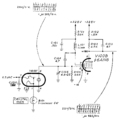180: Difference between revisions
No edit summary |
No edit summary |
||
| Line 28: | Line 28: | ||
The 180A, serial number 5599 and up, uses the [[120-119]] power transformer. | The 180A, serial number 5599 and up, uses the [[120-119]] power transformer. | ||
==Manuals== | |||
* [http://w140.com/tek-180a.pdf Tektronix 180A Manual (PDF)] | * [http://w140.com/tek-180a.pdf Tektronix 180A Manual (PDF)] | ||
* [http://w140.com/tek_fcp/tek_type_180_field_recal_proc.pdf Tektronix 180 Field Recalibration Procedure (PDF)] | * [http://w140.com/tek_fcp/tek_type_180_field_recal_proc.pdf Tektronix 180 Field Recalibration Procedure (PDF)] | ||
| Line 33: | Line 34: | ||
* [[Media:Tek 180 180a irb no ocr.pdf|Tektronix 180 and 180A Instrument Reference Book (PDF, needs OCR)]] | * [[Media:Tek 180 180a irb no ocr.pdf|Tektronix 180 and 180A Instrument Reference Book (PDF, needs OCR)]] | ||
==See Also== | |||
* [[Media:Gr oscillator calibration with 180a.pdf GR Oscillator Calibration with [[180A]] (PDF, needs OCR)]] | |||
==Photos== | |||
<gallery> | <gallery> | ||
Tek 180A front.jpg | Tel 180A Front Panel #1 | Tek 180A front.jpg | Tel 180A Front Panel #1 | ||
Revision as of 09:32, 29 May 2019
The Tektronix 180A was introduced in 1958 and is an all tube time mark generator with an oven-controlled crystal oscillator (OCXO). Time mark generators put out pulses at user-selectable intervals. They are primarily used for calibrating the time-base of oscilloscopes.
The signal path of the 180A starts with the OCXO, which produces 1 MHz. That waveform is divided down using synchronized monostable multivibrators. Switches on the front panel select which of the divided-down pulse signals will be added together to form the output waveform. This scheme does not require precision in the time constant of the monostable multivibrators. The only precision component in the 180A is the OCXO (part number 158-007).
In addition to the time mark generator functionality, the 180A also produces sine waveforms at 5 MHz, 10 MHz, and 50 MHz. These frequencies are produced by feeding the 1 MHz OCXO output to a series of three frequency multipliers. First the 1 MHz is quintupled to get the 5 MHz signal. Then the 5 MHz signal is doubled to the 10 MHz signal. Then the 10 MHz signal is quintupled, yielding the 50 MHz signal. Each of the three frequency multipliers is composed of a 6DK6 pentode driving an LC resonator tuned to 5 MHZ, 10 MHZ, and 50 MHz.
The 180A manual suggests an interesting procedure for calibrating the OCXO, by attaching a small antenna to deliberately interfere with the national time standard broadcast, and observing the interference with a communication receiver.
The Tektronix 180 has toggle switches. The 180A has pushbutton switches.
The 180A, serial number 5599 and up, uses the 120-119 power transformer.
Manuals
- Tektronix 180A Manual (PDF)
- Tektronix 180 Field Recalibration Procedure (PDF)
- Tektronix 180A Factory Calibration Procedure (PDF)
- Tektronix 180 and 180A Instrument Reference Book (PDF, needs OCR)
See Also
- [[Media:Gr oscillator calibration with 180a.pdf GR Oscillator Calibration with 180A (PDF, needs OCR)]]
Photos
-
Tel 180A Front Panel #1
-
Tek 180A Front Panel #2
-
Tek 180A Front Panel #3
-
Tek 180A Front
-
Tek 180A Front
-
Tek 180A Rear
-
Tek 180A Top
-
Tek 180A
-
Tek 180A Rear
-
Tek 180A Rear w/o Air Filter
-
Tek 180A Top w/o Cover
-
180A Block Diagram
-
Oscillator circuit in 180A using 158-007
-
180A internal
-
180A internal
-
180A internal
-
180A Internal - Tubes
-
Tek 180A Internal - Power Supply/Transformer
-
Tek 180A Internal - Main Chassis
-
Tek 180A Internal - Power Supply Tubes
-
Tek 180A Internal - Switches
-
Tek 180A Under Chassis w/o Cover
-
Tek 180A Internal Tubes Live
-
180A-RM in black
-
180A-RM in black
-
late sn power supply

























